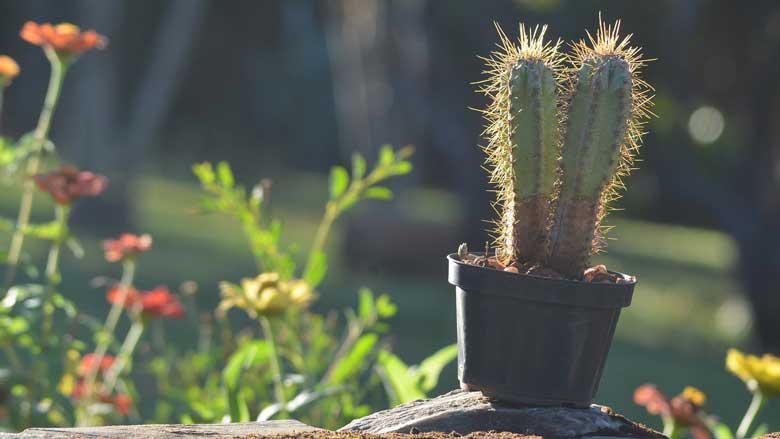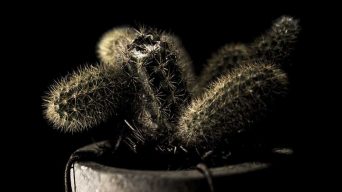If you’ve been noticing that your cactus is looking a bit squishy lately, there are a few possible reasons why.
A squishy cactus is a sign that something may be wrong and needs your attention.
In general, if your cactus is looking squishy, it’s a good idea to take a closer look at it and try to determine the cause of the problem so you can fix it.
Here are the most common reasons why your cactus may be squishy, as well as what you can do to fix it.
What Does It Mean if Your Cactus Is Squishy
When a cactus is squishy, it is not healthy and needs some attention.
This is a sign that the cactus has a lot of moisture inside and not enough dry air, or there is not enough moisture getting to the roots.
This will make it very difficult for the cactus to absorb water, and it will also make it very easy for the plant to rot, which will eventually kill the cactus.
Moisture is essential for a cactus, but if there’s too much of it, the cactus will become soft and squishy.
The excess moisture can lead to several problems, such as the plant rotting, mold growing, and pests attacking.
If you have a squishy cactus, you must take some steps to fix the problem.
The first thing you need to do is figure out why the cactus is retaining so much moisture in the first place.
There are several reasons why this might happen, and each will require a different solution.
Common Reasons Why a Cactus Is Turning Squishy and How to Fix Them
A cactus is a plant that thrives in dry, desert-like conditions.
That means that when it comes into contact with too much moisture, the plant becomes soft and squishy.
If you have a squishy cactus, there are reasons why this might be happening and some things you can do to fix it.
Here are some of the most common causes for why your cactus might become squishy and soft and what you can do about them.
Overwatering
One of the most common reasons a cactus becomes squishy is because it’s been overwatered.
Cacti are desert plants, and they don’t need a lot of water to survive. Too much water can kill them.
Cactus plants, like most succulents, store water in their leaves and stems to help them survive in dry climates.
When they’re given too much water, the plant can’t absorb it all, and the excess moisture will cause the cactus to become soft and squishy.
How to Fix It
If you think your cactus has been overwatered, there are a few things you can do to fix the problem.
The first thing you need to do is stop watering it. Wait until the top of the soil is dry before watering it again.
You might also want to wait a week or two after stopping the watering before you start up again.
This will give the plant time to adjust and absorb all of the new water.
You can also help your cactus dry out quicker by putting it in a place where it will get more sun.
Sunlight will help the plant to evaporate the water faster. You can also put the cactus in a spot where there is air circulation, like near a window or door.
If you have been watering your cactus too often, it might take a little while to bounce back.
Exercise patience and consistently provide proper watering; in due course, your cactus will regain its vitality.
Root Rot
If your cactus has been sitting in water for a long time or if the soil is too wet, it can develop root rot.
This will cause the plant to become soft and squishy, and eventually, it will die.
The fungal presence in damp conditions is responsible for inducing root rot in cacti.
When the fungus attacks the cactus’s roots, it will start to rot, and the plant will not absorb water or nutrients. This will cause the cactus to become weak and eventually die.
How to Fix It
If you think your cactus has root rot, you must remove it from the pot and cut away all the rotted roots.
Be very careful not to damage the healthy roots. You can then replant the cactus in a new pot with fresh soil.
Make sure you water it correctly and give it plenty of sun.
The rot can also spread to the rest of the plant, so keep an eye on it and cut away any other rotted parts.
When the rot has been cut away, it’s essential to sanitize the scissors or knife you used.
You can do this by dipping them in a solution of bleach and water. This will help prevent the rot from spreading to other plants.
If you catch the root rot early, your cactus might be able to recover.
If too much of the root system is rotted, however, your dying cactus will not be able to survive.
Poor Drainage
The soil will become wet and soggy if your cactus is in a pot with poor drainage. This will cause the cactus to become squishy and the roots to rot.
Poor drainage is often caused by a pot that is too small for the plant or a pot with no drainage holes.
The pot will fill up with water and not allow it to drain properly, which will cause the soil to become wet and soggy.
This can also be caused by using a potting mix that doesn’t allow water to drain properly.
Cactus need bright light and airy soil to drain the water.
If the soil is too heavy or clumpy, it will not allow the water to escape, and the cactus will become squishy.
How to Fix It
If your cactus is in a pot with poor drainage, you need to change the pot.
Choose a larger pot with drainage holes at the bottom than the current one.
Make sure to use a potting soil that is light and airy so that the water can drain properly. A cactus soil mix is perfect for this.
If the pot is too small, you can add a drainage layer to the bottom by filling it with rocks or gravel.
This will help keep the soil dry and prevent the cactus from becoming squishy.
If your cactus is in a pot with poor drainage, you need to water it less often. Wait until the top of the soil is dry before watering it again.
You can also water the cactus from the top instead of watering it from the bottom. This will help to get rid of any excess water that might be in the pot.
Also, you need to move it to a place where it will get more sun. Sunlight will help the plant to evaporate the water faster.
Humidity
If your cactus is in a humid environment, it can become squishy.
Cacti are not used to high humidity levels, and it can cause them to become soft and limp.
They need a dry environment to thrive, and if the humidity is too high, it can cause them to become damaged.
High humidity can cause the cactus to develop fungal diseases, which will cause the plant to become soft and squishy.
The fungus will also start to rot the roots of the cactus.
Humidity problems can also be caused by overwatering the cactus.
How to Fix It
If your cactus is in a humid environment, you need to move it to a place where the humidity is lower.
A dry, sunny spot is perfect for cacti.
You can also use a dehumidifier to lower the room’s humidity level.
If your cactus is in a humid environment, you need to water it less often. Wait until the top of the soil is dry before watering it again.
You can also water the cactus from the top instead of the bottom.
This will help to get rid of any excess water that might be in the pot.
Also, you need to move it to a place where it will get more sun. Sunlight will help the plant to evaporate the water faster.
Be sure not to expose it to direct sunlight, as the sun’s rays may harm the cactus.
Fungal and Bacterial Diseases
If your cactus is squishy and has black soft spots, it might be infected with a fungal infection or bacterial disease.
These diseases will cause the plant to become soft and limp.
Black spots on cactus plants are caused by fungus or bacteria, and they will spread to other parts of the cactus, eventually killing it.
Fungus on cactus plants can be caused by overwatering, high humidity, or poor air circulation. Bacteria can be caused by a dirty pot or soil or by using water that is not clean.
How to Fix It
If your cactus is infected with a fungal or bacterial disease, you must treat it with a fungicide or bactericide. You can also treat it with an organic fungicide, such as neem oil.
If your cactus is infected with a fungal or bacterial disease, you must remove any dead or rotting parts of the plant. This will help to stop the infection from spreading.
You also need to clean the pot and soil. Wash the pot in hot water and soap, and disinfect the soil by boiling it for 15 minutes.
Allow the pot and soil to dry completely before you use them again.
Try to prevent fungus and bacteria from infecting your cactus by keeping the pot and soil clean, watering the plant correctly, and moving it to a place where it will get more sun and less humidity.
These steps will help keep your cactus healthy and prevent it from becoming squishy.
Untreated Injuries
It might have been injured if your cactus is squishy and there are no black spots.
Injuries can be caused by falling off the pot, hitting a hard object, or getting too much sun.
Cactus injuries can also be caused by pests, such as mealybugs or scale insects.
When injuries are not treated, they can become infected, and the cactus will rot.
Also, injuries can cause the cactus to become weak and will not absorb water and nutrients from the soil.
How to Fix It
If your cactus is injured, you need to treat the injury as soon as possible.
You can treat it with a fungicide or bactericide if it is infected. You can also treat it with an organic fungicide, such as neem oil.
If the injury is not infected, the most you might need to do is clean it with mild soap and water.
If the injury is severe, remove any dead or rotting cactus parts.
You can use a sharp knife or scissors to cut off the damaged part of the plant. Ensure that you disinfect the knife or scissors before using them again.
You also need to move it to a place where it will get more sun and less humidity.
Sunlight will help the plant to evaporate the water faster. However, ensure not to place it in direct sunlight, as the sun can damage the cactus.
Insect Damage
Insects, such as mealybugs or scale insects, can also cause a cactus to become squishy.
These pests will feed on the sap of the plant and secrete a sticky substance called honeydew.
This substance will attract ants and other insects, damaging the plant further.
A pest infestation can also cause the cactus to become weak, and it will not be able to absorb water and nutrients from the soil.
How to Fix It
If your cactus is infested with insects, you must treat it with pesticides.
You can use an organic pesticide, such as neem oil, or a chemical pesticide.
Be sure to follow the directions on the label and take precautions when using a chemical pesticide.
You may consider manually removing the insects as an alternative. For smaller cacti, employing a Q-tip soaked in rubbing alcohol can effectively eradicate these pests.
Removing the insects by hand will be more difficult if you have a large cactus. You can use a hose to blast them off the plant or an insecticide soap spray.
Once the insects are gone, you must properly care for your cactus to help it recover. Prune off any damaged or dead parts of the cactus plant.
Water the cactus as needed and provide well-draining soil. You can also give the cactus a dose of fertilizer to help it recover.
Ensure you keep the cactus in a sunny location and protect it from frost.
If an infestation of pests causes the problem, you need to watch the plant for future infestations.
Why Is My Cactus Squishy at the Bottom?
There are a few reasons why your cactus might be squishy at the bottom.
One reason is that its pot is too small and doesn’t allow enough drainage.
When water can’t escape from the pot, it sits on top of the soil and makes the cactus roots wetter than they should be.
This causes the cactus to become squishy and even leads to root rot.
If your cactus is in a pot with good drainage, it might be squishy because it’s overwatered.
When a cactus is overwatered, the soil becomes saturated and can’t hold more water.
This causes the roots to become wet and leads to the same problems as when the pot doesn’t have good drainage.
The last reason your cactus might be squishy at the bottom is a fungus or a disease.
When a cactus plant has a fungus or disease, the roots and stem become soft and can easily be squished.
If your cactus is squishy at the bottom, there are a few things you can do to fix it.
The first thing is to repot the cactus into a pot with good drainage.
Make sure the pot is twice as big as the current pot and that the hole in the bottom is large enough for water to escape.
If the cactus is overwatered, you can fix it by letting it dry for a week or two. Don’t water the cactus, and make sure the pot is in a sunny spot.
If the cactus has a fungus or disease, you might need to remove the cactus from the pot and treat the roots and stem with a fungicide or organic treatment.
Let the cactus dry out for a week or two before repotting it into a new pot.
No matter the reason, take action if your cactus is squishy at the bottom. Otherwise, you might lose the cactus altogether.
So, take care of your cactus plant and keep it healthy!
Final Thoughts
So, why is my cactus squishy?
In short, this means that the cactus has excess moisture in its tissue or its roots are not properly absorbing water.
This could be due to several reasons: overwatering, incorrect potting mix, poor drainage, pests, or diseases.
You’ll need to determine the underlying cause to fix a squishy cactus.
Once you know why your cactus is squishy, you can take steps to correct the problem.
With proper care, your squishy cactus can be healthy and happy once again.







